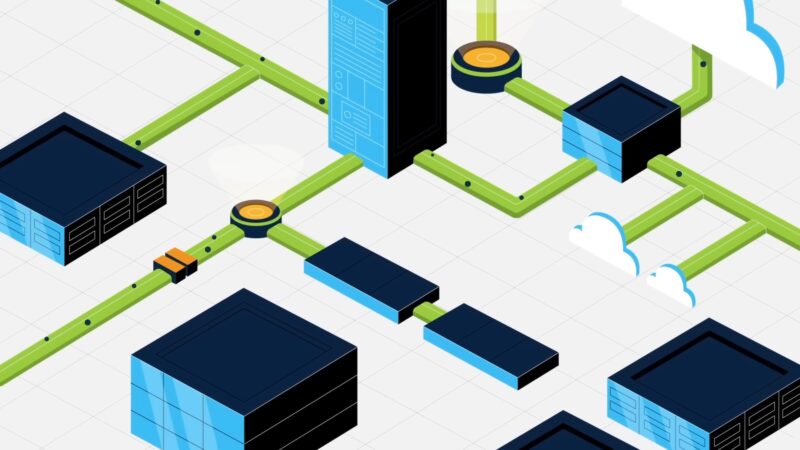When disaster strikes, a good disaster recovery plan can mean the difference between preserving data availability and suffering prolonged system downtime. As safeguarding data and services becomes more critical to protecting an organization’s brand reputation, today’s companies can no longer afford to wait until things go wrong to develop a plan for restoring their essential systems and safeguarding sensitive data.
Fortunately, by working with colocation data center providers, they can implement disaster recovery plans that ensure business continuity and minimize the potential of data breaches or data loss.
A data center disaster recovery strategy is a collection of tools and processes used to identify, mitigate, and recover from unexpected interruption of key IT services. It can be classified as a type of incident response plan.
When discussing disaster recovery, it’s important to note that there are many different types of “disasters” to recover from. Many may assume that the term simply applies to natural disasters—things like hurricanes, earthquakes, or floods that may damage a data center. There are other types of disasters that can disrupt service—such as large-scale DDoS attacks, ransomware infecting databases, simple network failures, employees accidentally deleting critical data, and so on.
Why Having a Disaster Recovery Strategy Is Essential

Having a disaster mitigation and recovery plan is a crucial part of threat management. Without an effective disaster recovery solution in place before a disaster strikes, it is more difficult to restore a disrupted data center to normal (or to launch a new production environment to host mission-critical software). The issue with this is that it delays the return to normal—which can cost businesses a significant amount of money in the form of lost opportunities and increased operational disruption.
How much does downtime cost a business?
While the actual cost of network or application downtime can vary based on industry vertical and business size, a statistic cited by Atlassian indicates that: “For Fortune 1,000 companies, downtime could cost as much as $1 million per hour… For eCommerce giant Amazon, whose entire business model relies on uptime, estimated costs are around $13.22 million per hour.”
Every second that a business’ network or services are unavailable can mean another opportunity lost to a competitor or a dissatisfied customer who leaves in frustration.
Additionally, for some disasters, there is a risk of data loss that can have a long-term impact on the company’s operations. Losing critical data, such as customer payment data, accounts payable, accounts receivable, and digitally-stored IP information can cripple a company’s ability to operate.
For example, if accounts payable records are lost or corrupted, then a company may miss important payment deadlines, incurring extra fees or other penalties. Losing accounts receivable or customer payment data could severely impact cash flow.
By having a solid disaster recovery strategy in place, companies can minimize their downtime following a disaster—whether natural or man-made. This helps to save money and preserve the company’s reputation in the long run.
6 Data Center Disaster Recovery Best Practices
1. Assess Risks to Data and Operations

Before an organization can begin looking for a data center that can address its disaster recovery needs, it must determine what those needs are. In many cases, data and technology infrastructure develops organically as a business grows, long before anyone stops to think about potential risks that could pose a threat to operations.
A startup company in southern Florida, for instance, probably spends more time thinking about the innovative services that would bring in more customers rather than what it will do when a hurricane sweeps across the state. Implementing integrated risk management is a good first step to identifying the potential risks that a disaster situation might pose to an organization. The benefits of integrated risk management go far beyond disaster mitigation and recovery, but this approach can create a comprehensive picture of all the ways a disaster could impact operations and infrastructure.
2. Develop a Disaster Recovery Plan
Once risks have been identified, an organization can begin developing a data center disaster recovery plan that lays out procedures for addressing them. This should include a thorough assessment of data assets and mission-critical systems.
Detailed inventories need to identify where data is located, which systems should have priority in the event of a downtime situation, and which services are impacted by compliance requirements. Power redundancies need to be mapped out and a system for replicating data put in place. The disaster recovery plan should be readily available to IT personnel so that everyone knows what roles they’ll be expected to fulfill and which tasks should be prioritized in the event of a disaster.
3. Identify Off-Site Backup Locations
Backing up data off-site is one of the foundations of good disaster mitigation services. If data assets are stored in a single location, organizations open themselves up to a variety of risks, including increased downtime, ransomware attacks, and, in a worst-case scenario, data loss.
When selecting a location for replicated or backed-up data, it’s important to find a data center that isn’t going to be exposed to the same risks as the company’s primary data solution. For instance, a business in Houston is vulnerable to flooding, so it should seek out a back-up location that is close enough to allow for reasonably convenient access but far enough to be well clear of any threat that might impact the primary facility.
Austin, which is located a little over 165 miles to the west of Houston, is situated above a flood plain, making it an ideal choice for a backup data center disaster recovery site.
4. Plan to Resume Operations
Protecting data and assets from a disaster is only one part of the disaster recovery equation. The “recovery” portion of the term implies that companies need to think about how they will get their operations up and running again in the wake of a disaster event. A good disaster recovery plan should already have identified which systems are prioritized when services are offline, but eventually, things need to return to normal.
This could involve moving back into locations that were disrupted by a disaster, the recovery of a data network, or planning how to integrate new equipment to replace infrastructure damaged during the event. While a swing environment put in place to preserve operations and data availability during the disaster may be able to meet business needs for a period of time, it shouldn’t be considered a long-term solution.
5. Assign Roles for the Disaster Recovery Team

Businesses need to have a dedicated team of individuals who have the ultimate responsibility for enacting a disaster recovery plan. Additionally, every person in the organization should have a role with defined responsibilities for what to do in the event of a disaster that disrupts the network—even if that role is to simply report the incident to someone on the disaster recovery team.
A solid disaster mitigation and recovery team should include the following:
- Executive Leadership. While they don’t need to be involved in all aspects, senior leadership should participate in discussions since they’re the ones signing off on the disaster recovery budget.
- IT Management. IT leaders within the organization are the most likely to understand the challenges and needs of the company’s IT environment, and what it will take to recover from various types of disruption.
- Business Unit Advisors. The people actually using the business applications may have valuable insights into what needs to work and what can be a lower priority from the perspective of unit operations. So, including critical business unit advisors can be useful in formulating a disaster recovery strategy.
- Security and Compliance Management. Because disastrous events can impact data availability and security, it’s important to include the staff in charge of security and compliance management in discussions regarding the company’s recovery strategy.
6. Update and Test the Plan

Situations and risk factors change as businesses grow and as new threats develop. Once a data center disaster recovery plan is in place, organizations shouldn’t simply throw it in a drawer and assume that it will be every bit as viable five years from now as it is today.
Changes in data availability needs or business growth are two of the primary reasons why disaster recovery plans need to be re-evaluated on a regular basis. As part of that reassessment, the plan itself should be tested frequently as part of ongoing disaster mitigation services.
Having a solid plan in place won’t count for much in a crisis if no one is familiar with how it’s supposed to work in practice. Testing a plan can also reveal gaps and inaccurate assumptions that could compromise data availability or make it more difficult to get systems back online in the aftermath of a disaster.
For these reasons, ongoing testing is essential to any proactive approach to disaster recovery.
Disaster Mitigation Services via Colocation Data Centers

Many colocation facilities offer a variety of disaster mitigation services that make it easier to implement a disaster recovery plan. With redundant infrastructure that ensures high levels of data availability, these facilities can help companies keep their lifeline services up and running even in the event of significant disasters.
They also have the connectivity to facilitate hybrid cloud backup solutions capable of meeting a variety of recovery time objectives. If the colocation provider operates a variety of data center locations, their disaster mitigation services can easily accommodate data replication at a secondary site. Some facilities even offer the convenience of work area recovery spaces that allow companies to relocate their operations to the data center location while they execute their disaster recovery plan to get their business back on its feet.
Developing a good data center disaster recovery strategy is essential for ensuring business continuity in the face of substantial risk. Colocation data centers can play a crucial role in this process by facilitating data backup and offering other disaster mitigation services that allow companies to ensure uptime reliability and data integrity. By partnering with a provider that can accommodate disaster recovery needs, organizations can protect themselves from the threat of system downtime and keep focused on growing their business rather than worrying about unknown risk factors.
Final Words
In today’s data-driven world, a robust disaster recovery plan is not just a best practice; it’s a necessity for businesses of all sizes. Whether facing natural disasters or cyber threats, organizations must prioritize data center disaster recovery to ensure business continuity and protect their brand reputation. Partnering with colocation data center providers can significantly enhance disaster mitigation services and help businesses minimize downtime and data loss.
Related Posts:
- 10 Data Center Migration Best Practices: Ensuring a…
- The Best 8 Practices for Effective Mobile App Testing
- Best Practices for Securing Your PC and Avoiding Malware
- Agile Development ─ The Benefits and Best Practices…
- How Jewelry Plays a Role in Holistic Wellness…
- Why Your Data Center Needs an Attestation of Compliance








